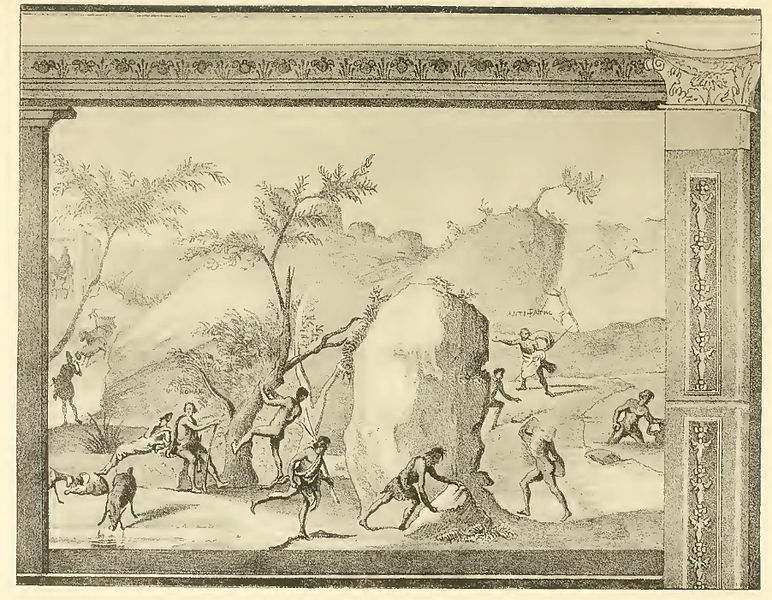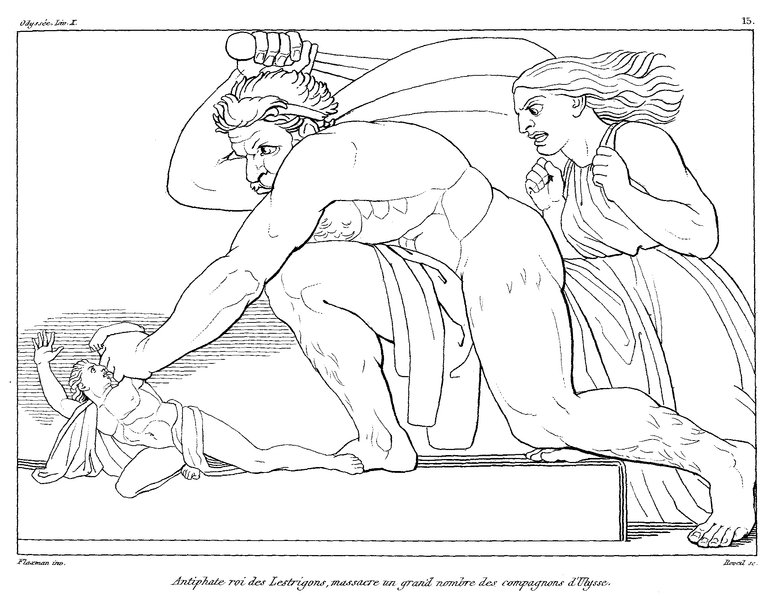The Laestrygonians was a tribe of man-eating giants, casting a shadow of terror and intrigue. These formidable beings, with their roots deeply embedded in ancient tales, have fascinated scholars and enthusiasts alike, particularly due to their encounter with the legendary hero, Odysseus.
Key Facts
| Creator | Sprung from Laestrygon, son of Poseidon |
| Defeated by | None (Odysseus escaped them) |
| Habitat | Southeast Sicily |
| Other names | Laestrygones |
| Roman name | Not Applicable |
| Associated with | Man-eating giants |
| Symbols | Rocks (used as weapons) |
Name and Etymology
The Laestrygonians, sometimes referred to as the Laestrygones, derive their name from the Greek “Λαιστρυγόνες”. The etymology of this name remains a subject of debate among scholars. Some believe it’s connected to the Lestriconi, a branch of the Corsi people from the northeast coast of Sardinia.
The Romans, however, didn’t have a direct counterpart for these giants, making the Laestrygonians unique to Greek tales. Over time, various epithets and alternative names have been associated with them, but their most defining characteristic remains their insatiable appetite for human flesh.

Laestrygonians Origin and Creation
The Laestrygonians are believed to have sprung from Laestrygon, who was the son of the mighty sea god, Poseidon. Their exact origin story isn’t as detailed as some other creatures in Greek mythology, but their association with Poseidon gives them a divine and fearsome lineage. Their habitat, as mentioned by ancient historians like Thucydides and Polybius, was southeast Sicily. This connection to a real geographical location adds a layer of authenticity to their myth, blurring the lines between legend and history. Some even speculate that the tales of these giants might have been inspired by real events or encounters, though these are, of course, theories.
Depiction And Characteristics
These giants, as their name suggests, were massive in stature. Their size was their most distinguishing feature, making them a formidable foe for any who crossed their path. While specific details about their appearance vary across sources, their association with launching rocks and their man-eating tendencies paint a picture of beings you wouldn’t want to encounter on a dark night—or any time, for that matter.
Laestrygonians Nature and Abilities
The Laestrygonians were not just giants in size; their appetites were equally gargantuan. Their most infamous tale involves them feasting on Odysseus’s men, showcasing their carnivorous tendencies. Their behavior was aggressive and predatory, with a penchant for destruction. When Odysseus and his crew landed on their shores, the giants destroyed eleven of his twelve ships, launching rocks from high cliffs. This act of aggression wasn’t just about defense; it was about their insatiable hunger for human flesh.
Their immense size granted them strength far beyond that of regular men. Their ability to hurl massive rocks with deadly accuracy was a testament to their power. But it wasn’t just physical strength that made them dangerous. Their strategic location in a harbor surrounded by steep cliffs made escape nearly impossible for unsuspecting sailors. This natural fortress, combined with their strength, made them nearly unbeatable.
Laestrygonians Symbols or Associations
Rocks, which they used as deadly projectiles, are the primary symbols associated with the Laestrygonians. These rocks, combined with the cliffs they inhabited, became tools of destruction in their hands. Their association with these elements of nature underscores their raw, untamed power and their connection to the earth.
Myths about Laestrygonians
The Laestrygonians, a tribe of cannibalistic giants, have left an indelible mark on Greek mythology, particularly in the epic poem, “The Odyssey.” Their role in the narrative is both harrowing and pivotal, serving as one of the many challenges faced by the hero, Odysseus, on his journey back to Ithaca.
Odysseus’s Encounter with the Laestrygonians
After facing numerous challenges on various islands, Odysseus and his crew found themselves near the Island of the Laestrygonians. Exercising caution, Odysseus moored his ship outside the harbor, anchoring it to a rock. He then dispatched a few of his men to scout the island and assess potential threats.
The exploratory crew eventually encountered a tall young woman, who was on her way to fetch water. This woman, the daughter of Antiphates (the island’s king), guided them to her home. However, upon their arrival, they were met by a gigantic woman, the wife of Antiphates. She promptly alerted her husband, who wasted no time in seizing one of the men, killing, and consuming him.
The remaining two scouts fled in terror, but Antiphates raised an alarm, prompting other giants to join the chase. These giants, displaying both cunning and brute strength, targeted the ships moored at the harbor, bombarding them with boulders. The result was catastrophic: all ships, save for Odysseus’s, were sunk. The men aboard either drowned or were captured by the ravenous giants. Witnessing the unfolding chaos, Odysseus and his remaining crew made a hasty retreat, leaving behind their doomed comrades.
The Inspiration Behind the Laestrygonians
The Laestrygonians’ island reportedly had a unique geographical feature: a harbor encircled by steep cliffs with just one narrow entrance. Ships had to moor closely together when they entered this harbor because of the limited space. Another legend said that a man who could avoid sleep would earn double wages since the inhabitants worked both day and night.
Historians believe that the island’s description and lifestyle align with that of Sardinia, specifically Porto Pozzo, which might have inspired Homer. Furthermore, the Laestrygonians’ origin might be traced back to Greek sailors’ sightings of the Giants of Mont’e Prama, ancient stone figures on the Sardinian peninsula. These sightings likely gave rise to tales of giant, cannibalistic humans, culminating in the creation of the Laestrygonians myth.
The Role of Laestrygonians in The Odyssey
The Laestrygonians serve as a significant obstacle in Odysseus’s journey. Their encounter highlights the perilous nature of his voyage and the constant threats he and his crew faced. This particular episode underscores the theme of struggle and survival against overwhelming odds.
Moreover, the Laestrygonians’ episode brings forth Odysseus’s human side. While he is portrayed as a near-perfect figure in “The Iliad,” “The Odyssey” reveals his vulnerabilities. The loss of his men to the Laestrygonians fills him with guilt and sorrow, reminding readers of his mortality and fallibility.
The encounter also reinvigorates Odysseus’s determination to return to Ithaca. It serves as a grim reminder of the challenges ahead and strengthens his resolve to overcome them. The Laestrygonians, while not the primary antagonists, play a crucial role in shaping Odysseus’s journey and character development.
Representations Of Laestrygonians In Art
While not as commonly depicted as some other creatures from Greek mythology, the Laestrygonians have made their mark in art. One notable representation is the fourth panel of the “Odyssey Landscapes” wall painting from the Vatican Museums in Rome, dated 60–40 B.C.E. This artwork captures the terror and scale of these giants, providing a visual representation of the tales that have been passed down through generations.

Mentions in Ancient Texts
The Laestrygonians are prominently mentioned in Homer’s “Odyssey”, where their encounter with Odysseus is detailed. This ancient text, a cornerstone of Greek literature, provides the most comprehensive account of these giants. Thucydides and Polybius, two ancient historians, also reference the Laestrygonians, placing them in southeast Sicily. These mentions, spread across different texts, highlight the significance of the Laestrygonians in Greek culture and mythology.
Frequently Asked Questions
They ate many of his men and destroyed eleven of his twelve ships by launching rocks from cliffs.
They inhabited southeast Sicily, according to ancient historians.
Yes, the Romans did not have a direct counterpart for these giants.
Their man-eating tendencies and their encounter with Odysseus.
Featured Image Credit: J. C. Andrä, Public domain, via Wikimedia Commons
